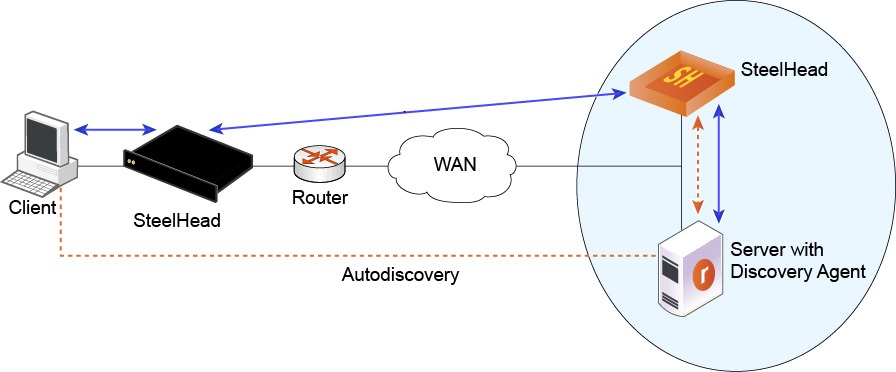Overview of the Discovery Agent
The Discovery Agent is a software package that you download from the Riverbed Support site and install on the client or server in the cloud that is optimized.
In a server-side Discovery Agent deployment, when a client SteelHead connects to a server
with Discovery Agent installed, the Discovery Agent redirects any autodiscovery probe request to SteelHead-c from its list. Then, the client SteelHead discovers and starts peering and optimizing with the server-side SteelHead-c. After the autodiscovery process completes, the connection is terminated locally with the SteelHeads without going over the WAN.
In a client-side Discovery Agent deployment, when a client with Discovery Agent installed connects
to a server, the Discovery Agent redirects any TCP connection to a configured SteelHead-c from its list. Then, the client-side SteelHead-c sends an autodiscovery probe, discovers the remote SteelHead,
and starts peering and optimizing with it.
The Discovery Agent provides these features:
• Optimization - Enables you to intercept (and optimize) inbound and outbound connections from the cloud.
• Autodiscovery - Enables SteelHeads to automatically find SteelHead-c virtual appliances and to optimize traffic through them. Autodiscovery relieves you of having to manually configure the SteelHeads with fixed target rules to find the remote SteelHead-c.
• Transparency - Enables the application on the server to continue to send and receive data from the same client IP address (as if there was no SteelHead) so that logging, reporting, or any feature that uses the IP address continues to work the same as before you configured the SteelHead.
• Failure detection - Detects SteelHead-c failures and connectivity issues to the SteelHead-c so that traffic can be passed through instead of being redirected to the failed SteelHead-c.
• Load balancing - Redirects all traffic to the SteelHead you select. If there are multiple SteelHeads in the group, the Discovery Agent uses the round-robin or priority load balancing method to select a SteelHead. When the primary SteelHead is unavailable or overloaded, it redirects all new connections to the next SteelHead on the list.
Figure: Discovery Agent overview

In
Figure: Discovery Agent overview, the Discovery Agent enables the client-side SteelHead and the server-side SteelHead in the cloud to discover each other.
When the client connects to the server, the client-side SteelHead sends an autodiscovery probe to the server. The Discovery Agent redirects the autodiscovery probe to the SteelHead-c. The SteelHead-c sends an autodiscovery probe response back to the Discovery Agent, which sends it to the client-side SteelHead. After the client-side SteelHead receives the probe response, it starts peering with the SteelHead-c to intercept and optimize the connection from the client to the server.
The Discovery Agent running on the server machine provides transparency using network address translation (NAT) on the packets between the server-side SteelHead and the server to seem as if they are between the client and the server.
Similarly, it provides transparency for the client-side SteelHead in the cloud. The Discovery Agent translates outer connection packets, between the client-side SteelHead in the cloud and the client in the cloud, on the client machine to seem as if they are between the server and the client.


